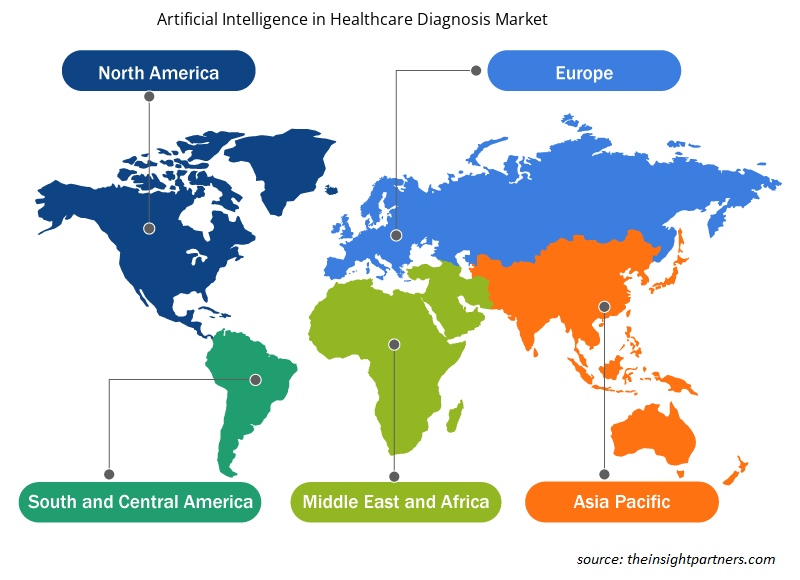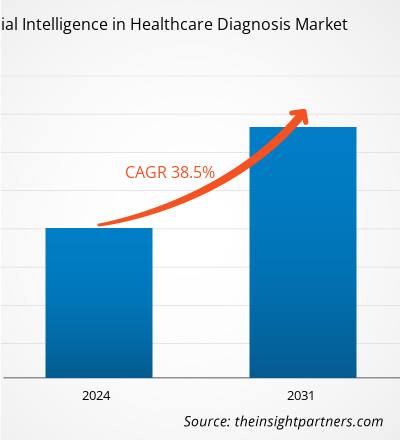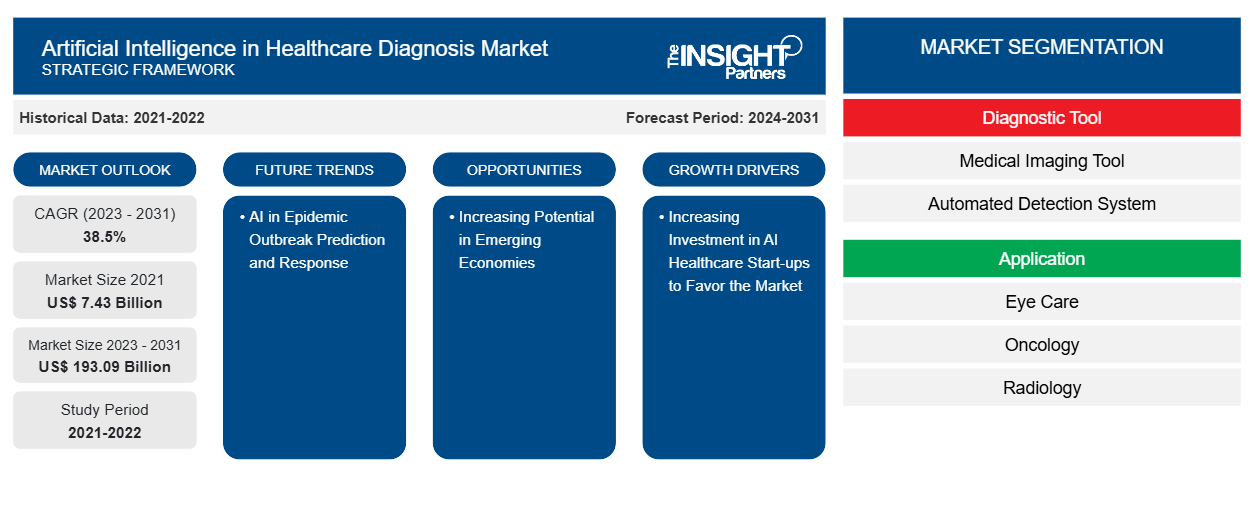의료 진단 시장에서 인공지능은 2021년에 74억 3천만 달러, 2023년에는 xx억 달러로 추산되었습니다. 2031년까지 1,930억 9천만 달러에 도달할 것으로 예상되며 2031년까지 38.5%의 CAGR을 기록할 것으로 예상됩니다. AI 기반 영상 솔루션, 원격 모니터링 및 원격 진료, 예측 분석 및 조기 감지는 의료 진단 시장 동향에서 핵심 인공지능으로 남을 가능성이 높습니다.
의료 진단 시장 분석의 인공지능
질병 진단 및 식별에 인공지능(AI)을 도입하는 것이 증가하고 AI 헬스케어 스타트업에 대한 투자가 증가하는 것과 같은 시장을 주도하는 주요 요인이 시장 성장을 주도할 것으로 예상됩니다. 진단 절차에 AI를 통합하는 것은 진단 및 환자 치료 산업을 변화시키고 있습니다. 예를 들어, 2023년 10월 Philips는 스페인에 본사를 둔 Quilbim과 협력하여 자기공명(MR) 전립선 검사를 지원하는 AI 영상 및 보고 도구를 제공했습니다.
하지만 숙련된 AI 인력의 부족과 의료 소프트웨어에 대한 모호한 규제 지침은 시장 성장을 방해하고 있습니다.
헬스케어 진단 시장 개요의 인공지능
글로벌 의료 진단 인공지능 시장은 북미, 유럽, 아시아 태평양, 중동 및 아프리카, 남미 및 중미로 지역별로 세분화됩니다. 이 지역의 시장 성장은 의료비 절감 필요성 증가, 의료 분야에서 빅데이터 의 중요성과 같은 요인으로 인해 예상되며 , 이는 성장을 주도하는 요인입니다. 또한 의료 분야에서 AI 기반 도구의 적용 가능성 증가와 자본 투자 증가도 있습니다. 또한 질병 진단 및 식별 분야에서 인공지능(AI) 채택 증가와 AI 의료 스타트업에 대한 투자 증가는 예측 기간 동안 시장 성장으로 이어지고 있습니다.
귀하의 요구 사항에 맞게 이 보고서를 사용자 정의하세요
이 보고서의 일부 또는 국가 수준 분석, Excel 데이터 팩을 포함하여 모든 보고서에 대한 사용자 정의를 무료로 받을 수 있으며 신생 기업 및 대학을 위한 훌륭한 혜택과 할인 혜택을 이용할 수 있습니다.
-
이 보고서의 주요 시장 동향을 알아보세요.이 무료 샘플에는 시장 동향부터 추정 및 예측까지 다양한 데이터 분석이 포함됩니다.
의료 진단 시장의 인공지능 동인 및 기회
시장을 활성화하기 위한 제품 출시 증가.
의료 분야의 AI는 지금까지 가장 중요한 기술 발전 중 하나입니다. 의료 스타트업은 AI 기반 진단 및 치료 솔루션을 개발하고 있으며, 이는 연구 기간 동안 시장 성장을 담당하는 주요 요인입니다. 2023년 5월, Lumibird Medical은 인공 지능(AI) 알고리즘을 활용하는 건조증 진단 지원 플랫폼인 C.DIAG를 출시했습니다. 마찬가지로 2024년 4월, General Electric Company는 Vscan Air SL에서 진료 시점에서 심장을 빠르게 평가하기 위한 인공 지능(AI) 기반 소프트웨어인 Caption AI를 출시했습니다.
신흥 경제권의 잠재력 증가 – 헬스케어 진단 시장에서 인공지능의 기회
AI는 또한 신흥 시장의 열악한 인프라로 인한 제약을 개선하여 원격 지역 사회를 포함하여 가장 필요로 하는 사람들에게 서비스를 제공하기 위한 대안과 비용 효율적인 솔루션을 제공할 수 있습니다. 모바일 네트워크의 광범위한 적용 범위를 활용하여 AI는 조기 질병 진단을 위한 원격 의료에 사용되어 광범위한 지역 사회 보건 종사자 네트워크를 유지하는 데 드는 비용을 절감합니다. AI는 암 검진 및 치료에서 타겟팅된 대규모 개입에 대한 놀라운 도달 범위를 제공합니다. 인도는 매년 100만 건 이상의 신규 암 사례가 발생합니다. 이 숫자는 인도의 노령 인구 증가와 라이프스타일 변화로 인해 증가할 가능성이 높습니다. 매년 100만 건 이상의 신규 암 사례가 발생하는 인도에는 종양학 분야의 경험이 풍부한 병리학자가 겨우 2,000명이며 종양병리학자로 간주될 수 있는 병리학자는 500명 미만입니다.
따라서 진단 솔루션에 AI를 통합하면 신흥국에서 더욱 회복력 있고 지속 가능한 의료 시스템을 구축할 수 있습니다.
의료 진단 시장 보고서 세분화 분석의 인공지능
의료 진단 시장 분석에서 인공지능에 기여한 주요 세그먼트는 서비스와 애플리케이션입니다.
- 진단 도구를 기준으로, 의료 진단 시장의 인공지능은 의료 영상 도구 , 자동 감지 시스템 등으로 구분됩니다. 의료 영상 도구 부문은 2023년에 더 큰 시장 점유율을 차지했습니다. 그러나 자동 감지 시스템은 예측 기간 동안 시장에서 가장 높은 CAGR을 기록할 것으로 예상됩니다.
- 시장은 눈 관리, 종양학, 방사선학, 심혈관 및 기타로 응용 분야별로 세분화됩니다. 종양학 부문은 2023년에 시장에서 가장 큰 점유율을 차지했습니다. 그러나 방사선학 부문은 예측 기간 동안 시장에서 가장 빠른 성장률을 보일 것으로 예상됩니다.
- 최종 사용자별로, 의료 진단 시장의 인공 지능은 병원 및 진료소, 진단 실험실, 홈 케어로 세분화되었습니다. 병원 및 진료소 부문이 시장 점유율이 가장 높았고, 진단 실험실 부문은 예측 기간 동안 시장에서 가장 빠른 성장률을 보일 것으로 추정됩니다.
- 서비스 기준으로, 의료 진단 시장의 인공지능은 원격 상담, 원격 모니터링 및 기타 서비스로 세분화되었습니다. 원격 상담 세그먼트는 시장에서 가장 큰 점유율을 차지한 반면, 원격 모니터링 세그먼트는 예측 기간 동안 시장에서 가장 높은 CAGR을 기록할 것으로 추정됩니다.
지역별 의료 진단 시장 점유율 분석의 인공지능
의료 진단 시장 보고서의 인공지능의 지리적 범위는 주로 북미, 아시아 태평양, 유럽, 중동 및 아프리카, 남미/남중미의 5개 지역으로 나뉩니다.
북미는 의료 진단 시장에서 인공지능의 가장 큰 시장으로, 미국이 가장 큰 시장 점유율을 차지하고 있으며, 그 다음은 캐나다입니다. 미국 시장 성장은 의료 비용 절감 필요성, 의료에서 빅데이터의 중요성 증가, 자본 투자 증가와 같은 요인에 의해 주도되고 있으며, 이는 의료 진단에서 AI에 대한 수요에 기여하고 있습니다. 마찬가지로 캐나다에서는 전국적으로 AI 기반 기술을 구현하려는 정부 이니셔티브가 증가하면서 시장 성장에 기여하고 있습니다.
아시아 태평양 지역은 글로벌 시나리오에서 의료 진단 분야에서 인공 지능이 가장 빠르게 성장하는 시장입니다. 이 지역은 중국, 인도, 일본, 호주, 한국 및 나머지 아시아 태평양 지역을 기준으로 분석됩니다. 이 지역은 의료 전문가 부족, 만성 질환 유병률 증가, 스타트업에 대한 투자 증가 및 이 지역의 의료 인프라 개선으로 인해 시장 성장에 대한 여러 성장 기회가 있을 것으로 예상됩니다.
의료 진단 시장의 인공지능 지역 통찰력
Insight Partners의 분석가들은 예측 기간 동안 의료 진단 시장에서 인공 지능에 영향을 미치는 지역적 추세와 요인을 철저히 설명했습니다. 이 섹션에서는 북미, 유럽, 아시아 태평양, 중동 및 아프리카, 남미 및 중미의 의료 진단 시장에서 인공 지능 세그먼트와 지역에 대해서도 설명합니다.

- 헬스케어 진단 시장에서 인공지능을 위한 지역별 특정 데이터를 얻으세요
헬스케어 진단 시장 보고서 범위의 인공지능
| 보고서 속성 | 세부 |
|---|---|
| 2021년 시장 규모 | 74억 3천만 달러 |
| 2031년까지 시장 규모 | 1930억 9천만 달러 |
| 글로벌 CAGR (2023-2031) | 38.5% |
| 역사적 데이터 | 2021-2022 |
| 예측 기간 | 2024-2031 |
| 다루는 세그먼트 |
진단 도구로
|
| 포함된 지역 및 국가 |
북아메리카
|
| 시장 선도 기업 및 주요 회사 프로필 |
|
의료 진단 시장 플레이어 밀도에서의 인공지능: 비즈니스 역학에 미치는 영향 이해
의료 진단 시장에서의 인공지능 시장은 소비자 선호도의 변화, 기술 발전, 제품의 이점에 대한 인식 증가와 같은 요인으로 인해 최종 사용자 수요가 증가함에 따라 빠르게 성장하고 있습니다. 수요가 증가함에 따라 기업은 제품을 확장하고, 소비자의 요구를 충족하기 위해 혁신하고, 새로운 트렌드를 활용하여 시장 성장을 더욱 촉진하고 있습니다.
시장 참여자 밀도는 특정 시장이나 산업 내에서 운영되는 회사나 기업의 분포를 말합니다. 주어진 시장 공간에 얼마나 많은 경쟁자(시장 참여자)가 존재하는지 그 규모나 전체 시장 가치에 비해 나타냅니다.
의료 진단 시장에서 인공지능을 활용하는 주요 기업은 다음과 같습니다.
- 마이크로소프트,
- Koninklijke Philips NV,
- 인텔 코퍼레이션,
- 제너럴 일렉트릭 회사,
- 알파벳 주식회사,
- NVIDIA CORPORATION,
면책 조항 : 위에 나열된 회사는 어떤 특별한 순서에 따라 순위가 매겨지지 않았습니다.

- 의료 진단 시장의 인공지능 주요 업체 개요를 알아보세요
헬스케어 진단 시장의 인공지능 뉴스 및 최근 개발
의료 진단 시장에서의 인공지능은 1차 및 2차 연구 이후의 질적, 양적 데이터를 수집하여 평가되며, 여기에는 중요한 기업 간행물, 협회 데이터 및 데이터베이스가 포함됩니다. 다음은 의료 진단 및 전략에서 인공지능 시장의 개발 목록입니다.
- 2023년 5월, Digital Diagnostics는 미국 남동부 지역에서 LumineticsCore Al 진단 시스템을 출시했습니다. LumineticsCore는 De Novo FDA 승인을 받은 자율 AI 진단 시스템입니다(출처: 회사 보도 자료)
- 2021년 12월, F. Hoffmann-La Roche Ltd는 병리학자가 유방암 마커, Ki-67, ER 및 PR을 평가하는 데 도움이 되는 인공 지능(AI) 기반 디지털 병리학 알고리즘을 출시했습니다. (출처: 회사 보도 자료)
의료 진단 시장 보고서의 인공지능 범위 및 제공물
"의료 진단 시장 규모 및 예측(2021-2031)의 인공지능" 보고서는 아래 영역을 포괄하는 시장에 대한 자세한 분석을 제공합니다.
- 범위에 포함된 모든 주요 시장 세그먼트에 대한 글로벌, 지역 및 국가 수준의 시장 규모 및 예측
- 동인, 제약 및 주요 기회와 같은 시장 역학
- 주요 미래 트렌드
- 자세한 PEST/포터의 5가지 힘과 SWOT 분석
- 주요 시장 동향, 주요 업체, 규정 및 최근 시장 동향을 포괄하는 글로벌 및 지역 시장 분석
- 시장 집중도, 히트맵 분석, 유명 기업 및 최근 개발 사항을 포함하는 산업 환경 및 경쟁 분석
- 자세한 회사 프로필
- 과거 분석(2년), 기준 연도, CAGR을 포함한 예측(7년)
- PEST 및 SWOT 분석
- 시장 규모 가치/거래량 - 글로벌, 지역, 국가
- 산업 및 경쟁 환경
- Excel 데이터세트
최근 보고서
관련 보고서
사용 후기
구매 이유
- 정보에 기반한 의사 결정
- 시장 역학 이해
- 경쟁 분석
- 고객 인사이트
- 시장 예측
- 위험 완화
- 전략 기획
- 투자 타당성 분석
- 신흥 시장 파악
- 마케팅 전략 강화
- 운영 효율성 향상
- 규제 동향에 발맞춰 대응























 무료 샘플 받기 - 의료 진단 시장의 인공지능
무료 샘플 받기 - 의료 진단 시장의 인공지능